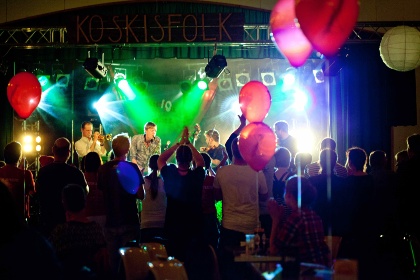By Morten Alfred Høirup
Picture a typical summer festival somewhere in Europe. It is getting late, the sun has gone down, and the audience gather in front of the main stage. No-one knows exactly
what is going to happen now, and people are curious. Finally, the compere introduces the next performers, a band from Denmark, and out on stage come nine young men
with saxophone, trombone, trumpet, guitar, keyboard, double bass, drums, accordion and violin. "How many of you have never, ever heard traditional Danish music?",
shouts the fiddler to the audience, and a forest of hands shoots up. "That many? We'll have to do something about that! Ladies and gentlemen: it's party time!". The music
that ensues is traditional, racing, up-tempo dance music from Denmark: polkas, jigs, reels and hopsas. The audience goes wild, dancing breaks out: some dance in couples,
some improvise, others just bounce happily on the spot, while horn riffs, guitar solos and salsa piano mix it with the more traditional-sounding violin and accordion.
"At first they glowered at Kristian's fiddle as if they'd never seen one before, but then things hit party mode"
The band Habadekuk has its roots at The Academy of Music and Dramatic Arts Southern Denmark, home of the country's only folk music course. A handful of folk music and jazz students, inspired by Canadian band La Bottine Souriante, started a
Danish folk big band, and Habadekuk was born.
"We started Habadekuk a few years back, because we thought Denmark needed a big, new, party band. The original idea was to blow some wild folk music into people's heads...", explains Kristian Bugge, Habadekuk's fiddler. His sideman, pianist
Theis Langlands, goes on: "Another part of the original idea was to play for a wider audience than usually listens to traditional Danish music, by confronting them with
Danish folk music with more power than they are used to. We played at a wild rock festival recently, it was around midnight, and masses of young folk were drawn in by
the music. At first they glowered at Kristian's fiddle as if they'd never seen one before, but then things hit party mode, and they went daft, hopping up and down and
throwing their knickers on to the stage. It was great fun."
"This music was originally made for dancing, and that's the energy we
want to put out."
Habadekuk's music is traditional Danish, and the band pick up the tunes from old Danish folk musicians, from ancient, dusty music books and old field recordings.
Most of the tunes are between 150 and 200 years old, back from the days when the tunes were played at harvest homes, weddings, Christmas parties and so on. Kristian
Bugge has specialised in traditional Danish folk music, and has played with and learnt from many of the old Danish folk musicians, among them 84 year-old
accordionist Karl Skaarup from Thy. The two still go out playing together occasionally.
Fortunately there are still dancers who keep the traditional Danish folk dances alive, and still musicians, young and old, who play the music, but not so many as in the
other Scandinavian countries. Sweden and Norway, for instance, have a long-standing tradition for training State Players (Rigsspillemand), and organising national and local competitions to find champions in various categories. This is unknown in
Denmark.
In 2009 Habadekuk won the Nordic Championship in Folk Music in Sälen in Sweden, in the Folk Group category. The prize, taken in the face of tough competition from top Swedish, Norwegian and Finnish bands, was worth 15,000
Swedish crowns. The victory meant that the Danish band could be heard in the national radios in all the Nordic countries - except Denmark! Danish State Radio has an unfortunate policy of totally ignoring Danish folk music. Since that success,
Habadekuk have been busy digging up more traditional music, playing concerts and recording their first album, which was released in may.
"We try to play different kinds of festival, where we can surprise audiences with hot music they didn't know about"
"We collect material and use the most exciting stuff. Inspiration for our arrangements often comes from other types of music. We try to play with enough energy to reach
out over the footlights and start a party...", says Kristian and Theis adds, "For those who don't know traditional Danish folk music, we say that it's a bit like Celtic music.
Different tunes, but the same feeling and sound. Very different from Swedish and Norwegian music." Kristian: "This music was composed for dancing, and that's the
energy we try to transmit, while at the same time playing music for listening. In the course of the next couple of years we'll be playing at folk music festivals in Denmark and abroad, but we are up for playing at different kinds of festival, too, where we can surprise audiences with hot music they didn't know about. See you out there!"
At a summer festival somewhere in Europe, it's late, and the party is in full swing. Danish folk big band, Habadekuk, are winding up their set, the audience are happy,
they are dancing. As the band tear into their encore, a rip-roaring Danish hopsa, Kristian wipes the sweat from his brow and screams out to the crowd: "Well, what do
you think of traditional music from Denmark now?"
The rest is history - or rather, the future!
article posted by:Rasmus Fribo, Habadekuk



